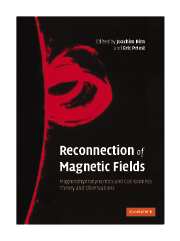Book contents
1 - Introduction
Published online by Cambridge University Press: 17 August 2009
Summary
The Sun and the Earth's magnetosphere (hereafter simply called the magnetosphere) play particular roles in the history of reconnection, frequently also referred to as magnetic merging, as well as in the most recent advances in understanding the spatial structure and the physics of reconnection sites. The concept of reconnection (although not the term) was first suggested by Giovanelli (1946) as a mechanism for particle acceleration in solar flares. This proposed mechanism was extremely modern, as it considered not only electric fields along magnetic neutral lines (as in standard two-dimensional (2D) models; Section 2.1) but also electric fields with a local component along the magnetic field, which is the basic concept of general three-dimensional (3D) magnetic reconnection (Sections 2.2 and 2.3).
Investigations of reconnection in the magnetosphere have stimulated the development of the concept of 3D reconnection in the absence of magnetic nulls (Hesse and Schindler, 1988; Schindler et al., 1988) and considerations of the interaction between a dipole (magnetosphere) and the surrounding (interplanetary) magnetic field have stimulated investigations of the topology of the magnetic field and topological changes associated with reconnection (Dungey, 1961, 1963). They have also motivated the first investigations into the 3D magnetic structure of magnetic null points (Greene, 1988; Lau and Finn, 1990). More recently, the complex structures of the coronal magnetic field, inferred from astonishing X-ray and EUV pictures, have motivated the further detailed exploration of the 3D topology of magnetic fields and its role in reconnection (Chapters 2 and 5).
- Type
- Chapter
- Information
- Reconnection of Magnetic FieldsMagnetohydrodynamics and Collisionless Theory and Observations, pp. 1 - 15Publisher: Cambridge University PressPrint publication year: 2007

